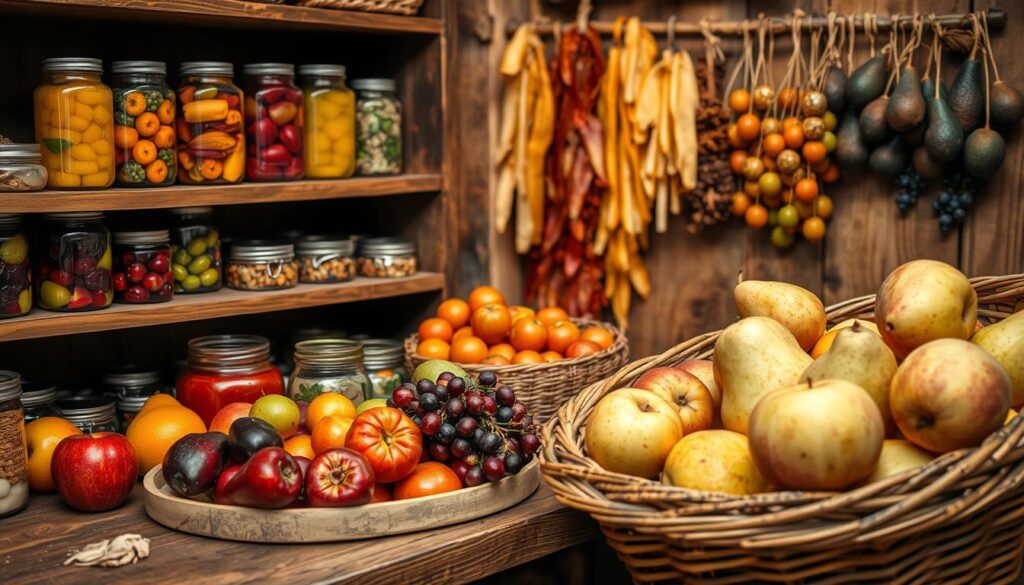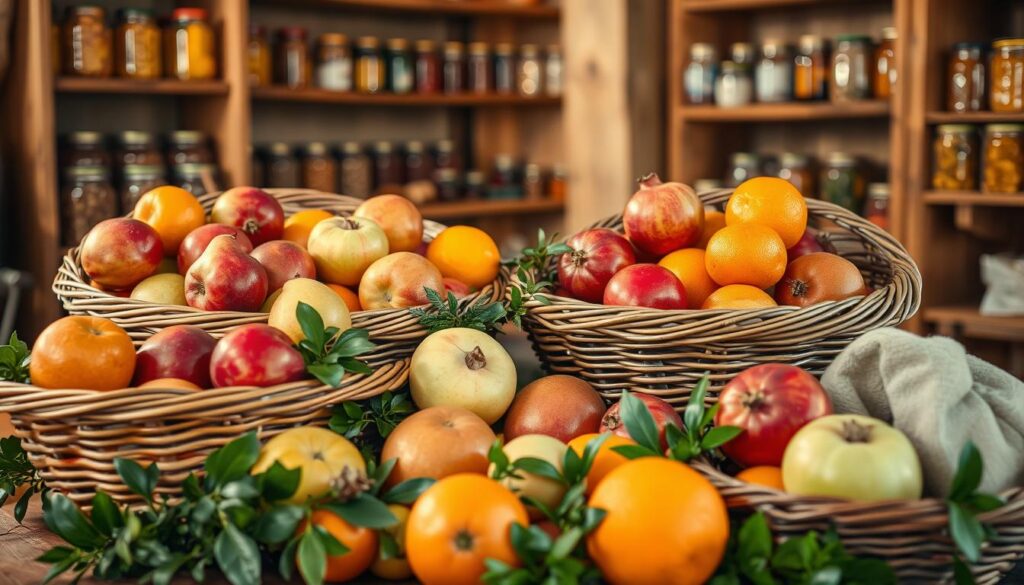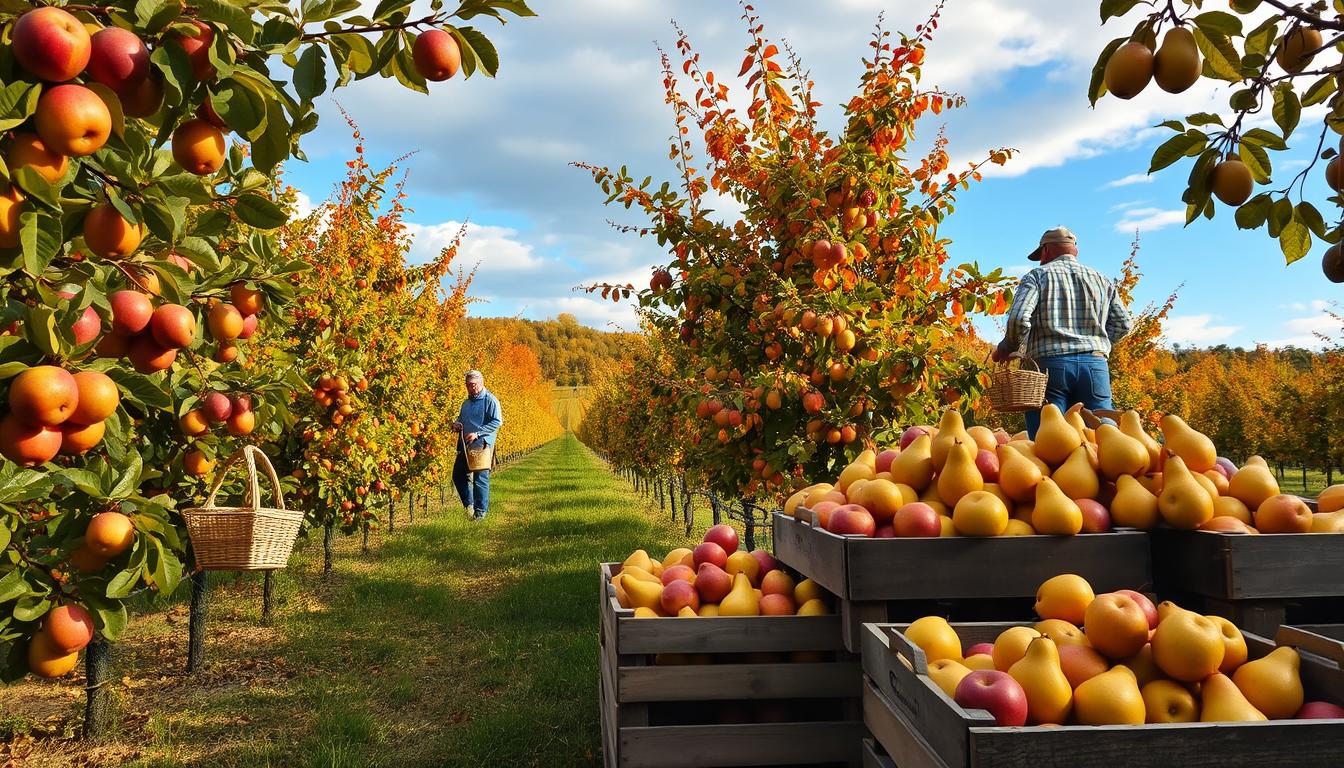As winter gets closer, it’s important to prepare for it, especially for keeping fresh fruits. Knowing how to harvest and store fruits for winter is key. It keeps them fresh and tasty for months. In this article, we’ll explore the best ways to preserve fruits, using expert advice.
Key Takeaways
- Understanding optimal harvest times is crucial for fruit quality.
- Ensure proper storage temperatures for various fruits to prolong freshness.
- Regular monitoring of stored fruits can prevent spoilage.
- Utilizing preservation methods like freezing can extend fruit usability.
- Different fruits require unique storage practices to avoid waste.
- Preparing fruits correctly before storage enhances their longevity.
Understanding the Importance of Winter Prep for Fresh Fruit
Getting ready for winter is key to keeping fresh fruits fresh. The right steps help them last longer and stay good. This way, I can enjoy my fruits even when it’s cold outside.
Knowing how to store each fruit is important. Some fruits give off gas that makes others ripen faster. By learning how to store fruits, I can keep them fresh for longer. The best storage temperature varies by fruit, which helps them last longer.
Protecting fruit trees in winter is also crucial. I use mulch to keep their roots warm and healthy. Painting the trunks with a special mix keeps them safe from the sun. And, cleaning up leaves and debris helps keep pests away.
Keeping trees well-watered helps them survive the cold. Pruning at the right time is also important. Doing it too late can harm the trees. Winter prep helps us eat local and supports our community.
| Winter Prep Action | Description |
|---|---|
| Apply Mulch | Protects root systems and prevents tree stress. |
| Paint Trunks | Prevents sun damage and cracking of the cambium layer. |
| Remove Debris | Reduces pest populations that can cause harm. |
| Maintain Hydration | Water in cells offers insulation from freezing. |
| Timely Pruning | Avoids vulnerability to frost and pest intrusion. |
Recognizing When to Harvest Fresh Fruits
Knowing when to pick fruits is key for the best quality. I look for color, firmness, and smell to check if they’re ripe. Each fruit has its own signs of readiness. Understanding these helps me pick at the perfect time, improving taste and storage.
Identifying Ripe Fruits
Different fruits show unique signs when they’re ready. Here are a few examples:
- Apples and pears detach easily from the tree when ripe.
- Cantaloupe is ready for harvest when the stem slips off effortlessly.
- Berries, such as raspberries, come away cleanly when ripe.
- Blackcurrants fully develop flavor after being left on the bush for a week post-darkening.
- Blueberries achieve optimal taste two to three days after changing color.
Knowing these signs helps me pick fruits in winter at their best.
Best Practices for Harvesting
Good harvesting practices are key to keeping fruits fresh. I follow these steps:
- Use clean and sharp tools to avoid damage.
- Handle fruits gently to prevent bruising and spoiling.
- Sort through harvested fruits, discarding any defective ones.
- Store harvested produce in controlled conditions for optimal freshness.
These steps help me harvest fruits in winter efficiently and keep them fresh longer. For more tips, I often check out Garden Beginner.
| Fruit | Ripeness Indicator | Harvesting Tips |
|---|---|---|
| Apples | Come away from the tree easily | Use clean pruners; handle with care |
| Cantaloupe | Stem slips easily | Cut with a sharp knife to avoid damage |
| Berries | Come away easily from the branch | Harvest in the morning for better flavor |
| Blueberries | Two to three days after turning blue | Store in a cool area post-harvest |
Following these practices helps me get the best fruits. Detailed guides on timing, like those on Acreage Nebraska, improve my skills.
How to Harvest and Store Fresh Fruit for Winter
Learning how to harvest and store fruits for winter is crucial. Each fruit needs a special way to keep it fresh. Using the right tools and methods helps keep your winter fruit supply fresh.
Harvesting Techniques for Different Fruits
Harvesting fruits requires knowing the right techniques for each type:
- Asparagus: Start harvesting two years after planting. Store in a plastic bag for 3-5 days in the fridge.
- Beans: Pick when pods are full and firm. Store in a plastic bag for about 1 week in the fridge.
- Broccoli: Harvest when heads are tight and before buds open. Lasts 7-10 days in a plastic bag in the fridge.
- Cabbage: Choose firm, full-size heads, mature 60-70 days after planting. Store in a cool, moist spot.
- Garlic: Harvest when tops start to yellow. Store in a dry place using mesh bags or braided tops.
- Potatoes: Harvest and store in a cool, dry spot for long-term storage.
Essential Tools for Harvesting
Having the right tools makes harvesting easier and keeps fruits from getting damaged. Here are some must-haves:
- Clean Shears: Great for cutting fruits without bruising them.
- Baskets: Use breathable containers to carry fruits and keep them aired.
- Gloves: Protect your hands and the fruit from dirt and germs.
After picking, it’s important to store fruits correctly. This includes cooling and packaging them right. Knowing how to harvest and store fruits for winter helps you enjoy fresh produce all winter long.
Effective Fruit Preservation Techniques
Using the right preservation methods is key to keeping fruits fresh and tasty. Each method has its own benefits. It’s important to pick the best one for the fruit and how long you plan to store it. I’ve found that different methods can keep fruits fresh and full of nutrients for a long time.
Curing Fresh Harvests
Curing is great for fruits like squash and onions. It makes the skin hard, helping to remove moisture. This makes the fruits last longer. Curing also makes the flavors stronger, making the fruits even more enjoyable months later.
Methods of Preserving Fresh Fruits
There are many ways to preserve fruits, each good for different needs:
- Freezing: Freezing fruits at their best keeps their flavor and nutrients.
- Canning: Sealing fruits in jars works well. Water bath canning is best for fruits with a lot of acid. Pressure canning is better for fruits with less acid.
- Dehydration: Dehydrating fruits removes moisture, stopping them from spoiling.
- Pickling: Soaking fruits in vinegar or brine makes them tangy and keeps them fresh longer.
- Fermentation: This old method not only keeps fruits fresh but also adds good bacteria, like in sauerkraut and kombucha.
Storing fruits in airtight containers is crucial. It keeps them fresh and prevents spoilage for a long time. For example, wrapping apples in newspaper helps keep them dry and fresh for longer.

| Preservation Method | Suitable Fruits | Benefits |
|---|---|---|
| Freezing | Basil, blueberries, cherries | Maintains peak freshness and nutritional value |
| Canning | Apples, strawberries | Long-term preservation with shelf-stable results |
| Dehydration | Figs, apricots | Compact storage and extended lifespan |
| Pickling | Cucumbers, carrots | Delicious transformation with increased shelf life |
| Fermentation | Grapes, pears | Promotes gut health alongside preservation |
By using these preservation techniques, I can keep my fruits fresh and nutritious. This reduces waste and makes the most of my gardening efforts.
Optimal Storage Conditions for Fresh Fruits
Storing fresh fruits right is key to keeping them fresh longer. Knowing the best storage conditions, like temperature and humidity, is crucial. If fruits are not stored properly, it can lead to big losses, up to 40 percent.
Temperature and Humidity Requirements
Fruits do best in cool places, between 32 to 55°F. They also need high humidity, 80 to 95 percent. This helps them last longer by slowing down how they breathe and grow.
For example, berries can stay fresh in the fridge for 2-3 days. Melons should be kept at room temperature for 3-4 days. High humidity keeps fruits heavy and full of nutrients.
Things like air movement and pressure also play a part. They affect how fruits lose moisture, showing the need for a careful balance in storage.
Creating Ideal Storage Environments
To create the perfect storage space, organize it well. This prevents temperature changes and helps air move, which stops fruits from spoiling. Using a thermometer and hygrometer helps keep an eye on these conditions.
By focusing on the right storage, you can make fruits last longer and cut down on waste. This makes customers happier. Regular checks let you adjust storage times to meet market needs. For more on keeping data safe online, check out this privacy policy.
Long-term Fruit Storage Strategies
I’ve found that using different techniques can really help keep fruits fresh all winter. Freezing and vacuum-sealing are two top methods for keeping fruits tasty and nutritious.
Using Freezing and Vacuum-Sealing
Freezing fruits right after picking helps keep nutrients like vitamin C. I pre-freeze soft fruits like berries on a tray before bagging them. This stops them from sticking together, making it easy to use them later.
Freezing also means blanching veggies briefly to clean them and kill bacteria. This makes them safer for long-term storage.
Vacuum-sealing is great because it stops freezer burn. This keeps fruits tasting fresh for smoothies, baking, or cooking. Even frozen bananas are a big help in the kitchen.
Understanding Drying Techniques for Fruits
Drying is another good way to store fruits for a long time. Air drying and oven drying let me enjoy fruits like peaches and apples even after they’re out of season. Dehydrating at low temperatures helps keep nutrients and flavor.
For variety, canning and pickling are also good options. They add flavor and make fruits last longer. Plus, labeling and storing properly can keep them good for 12-18 months, which is key for winter.
| Method | Description | Duration |
|---|---|---|
| Freezing | Preserves fruits by maintaining texture and flavor. | Best used within 6-12 months. |
| Vacuum-Sealing | Prevents freezer burn and retains quality. | Indefinite if stored properly. |
| Drying | Extends shelf life by removing moisture. | Up to 1 year for dried fruits. |
| Canning | Packs fruits in jars with liquid for preservation. | 1-2 years if sealed correctly. |
| Pickling | Enhances flavors and preserves vegetables. | 6 months to 1 year. |
For more tips on keeping fruits fresh, I like what’s on this website. It helps me understand and use my harvest better.
Fresh Fruit Storage Tips
To keep my fresh fruit fresh, I group them by their storage needs. This keeps them fresh longer and stops them from spoiling each other. Some fruits make ethylene gas, which can make others spoil faster. Using these tips can really help keep my fruit fresh.
Grouping Fruits Based on Storage Needs
Knowing which fruits can be stored together is key. Here are some tips:
- Apples should not be stored with potatoes because apples produce ethylene gas. This gas can make potatoes spoil faster.
- bananas, avocados, and tropical fruits like room temperature. But berries and stone fruits do better in the fridge.
- Keeping leafy greens in zip-top bags helps keep them fresh. It prevents too much moisture.
Avoiding Common Storage Mistakes
Knowing and avoiding common mistakes can really help. Here are some important tips:
- Don’t overcrowd storage containers. This can cause a lack of air and make fruits spoil faster.
- Always take out any damaged fruits right away. Spoiled fruits can make others spoil quicker.
- Check stored fruits often for signs of spoilage. Taking out spoiled fruits quickly helps keep the rest fresh.
Storing Seasonal Fruits Effectively
Properly storing seasonal fruits is key to keeping them fresh and tasty. Each fruit has its own needs. For instance, fruits like apples and bananas can ripen after they’re picked. On the other hand, fruits like blueberries won’t ripen once they’re picked. Knowing this helps me organize my storage better and set the right conditions for each fruit.
Best Practices for Different Types of Fruits
Learning the best ways to store fruits keeps them fresh and tasty. Here are some tips:
- Climacteric fruits: Fruits like bananas and peaches release ethylene gas. Store them at room temperature until they’re ripe. Then, refrigerate them to keep them fresh longer.
- Non-climacteric fruits: Fruits like strawberries and citrus should be refrigerated right after picking. Store them in containers that let air in to avoid moisture buildup.
- Cold-sensitive fruits: Fruits like avocados don’t like cold. Store them at room temperature, away from sunlight.
- Ethylene sensitivity: Fruits like broccoli should be kept away from fruits that release a lot of ethylene. This prevents them from spoiling too fast.
How to Organize Your Storage Space
Organizing your storage space well makes it easier to find what you need and keeps fruits fresh. Here are some tips:
- Group similar fruits: Store fruits by type to keep them in the best conditions.
- Avoid damaged fruits: Check your fruits regularly. Separate any damaged ones to prevent them from spoiling the rest.
- Utilize breathable containers: Use containers that let air in, like those with holes. This helps keep fruits fresh.
- Check humidity levels: Store fruits like carrots in a bit of moisture. But keep other fruits dry to prevent mold.

Fruit Preparation for Extended Storage
Getting your fruits ready for storage is key to keeping them fresh. Knowing how to clean and prep them helps them last longer. This way, they stay tasty and full of nutrients. Here, I’ll share important steps to keep your fruits in top shape for longer.
Cleaning and Prepping Fruits Before Storage
First, I clean my fruits well to get rid of dirt and harmful stuff. This is important because dirt can make them spoil faster. For berries, a vinegar bath helps kill mold and keeps them fresh.
After cleaning, I make sure to dry them off. This stops moisture from causing mold.
Handling Blemished Fruits Properly
When I find fruits with blemishes, I handle them carefully. Small blemishes are okay if you eat them fast. But big damage, like bruises, means they should go right away.
Storing damaged fruits with the good ones can make the good ones go bad fast. By following these steps, my fruits stay fresh and tasty for longer.
Want more tips on storing fruits? Check out this page for helpful advice: Contact Tips for Better Storage.
Monitoring Stored Fruits for Quality
It’s important to check on stored fruits often to keep them fresh during winter. Spotting spoilage early helps keep my harvest tasty and healthy. There are key signs that tell me when it’s time to act.
Signs of Spoilage to Look Out For
When I check on stored fruits, I look for these signs:
- Discoloration: Color changes mean fruits are getting old.
- Softness: Mushy texture means they’re too ripe or rotting.
- Mold: Moldy fruits need to be separated fast to stop it from spreading.
By watching for these signs, I can eat the less fresh fruits first or compost the bad ones.
Tips for Maintaining Fruit Quality Over Time
To keep fruits fresh, I follow these steps:
- Check on fruits every few days.
- Rotate the fruits so none are forgotten.
- Store them in a cool, humid place: 32 to 39 degrees Fahrenheit and 90% to 100% humidity.
| Fruit | Signs of Spoilage | Optimal Storage Conditions |
|---|---|---|
| Apples (e.g., Braeburn, Fuji) | Soft spots, discoloration | 32-39 °F, 90-100% humidity |
| Potatoes | Sprouting, softness | Above freezing but below 50 °F |
| Tomatoes | Wrinkling, mold | Cool, dry place |
| Berries (e.g., strawberries, blueberries) | Mushiness, mold | 32-39 °F, high humidity |
By using these methods and storage tips, I can enjoy fresh fruits all winter.
Storing Your Harvest Without a Root Cellar
Not everyone has a root cellar, but there are many ways to keep fruits and veggies fresh. I’ve found several effective methods to store my harvests without one. These options help keep my food fresh and tasty all winter long.
Alternative Storage Solutions
For centuries, people have used cold storage to keep food fresh. Today, I can use modern methods to store my fruits without a root cellar. Here are some reliable options:
- Basements: Creating a cold room in an unheated corner of my basement keeps food at the right temperature. Adding insulation and wooden structures makes it even better.
- Trash Can Method: Burying a metal trash can in the ground is a simple and cheap way to store root veggies.
- Refrigeration: Standard refrigerators work well for storing veggies and fruits that like cooler temperatures, like carrots and apples.
- Pallet Root Cellar: Building a pallet root cellar is a sturdy and practical way to store food for a long time.
- Moist Sand Containers: Using rubbermaid totes filled with damp sand creates a stable place for root crops.
Learning about these alternatives helps me plan better for storing food. For example, keeping fruits and veggies fresh often means keeping them below 60°F. This avoids extreme temperatures that can spoil food.
| Storage Method | Temperature Range | Suitable Crop Examples |
|---|---|---|
| Basements | 0-5°C | Carrots, beets, leeks |
| Trash Can | 0-5°C | Turnips, parsnips |
| Refrigeration | 32-40°F | Cabbage, apples |
| Pallet Root Cellar | 0-5°C | Potatoes, winter squashes |
| Moist Sand Containers | 0-5°C | Carrots, beets |
These methods show that I can keep fruits fresh without a root cellar. By exploring these options, I can adapt to my food’s needs. This ensures they stay fresh and tasty all winter.
Conclusion
Learning how to harvest and store fresh fruit for winter is key. It lets me enjoy my fruits long after they’re picked. By using the right techniques, I can keep my fruits tasting great and full of nutrients.
Understanding the needs of different fruits is crucial. This includes knowing how to freeze and can them. It helps me make choices that are good for my health and the planet.
Keeping fruits fresh for longer is also important. I focus on when they’re ripe and how they breathe. This way, I can keep them fresh for months, even in cold weather.
Florida, for example, grows many fruits that can be stored well. By using these tips, I can keep my fruits fresh and tasty all winter.
My goal is more than just preserving fruits. It’s about enjoying seasonal fruits and reducing waste. This knowledge makes cooking more fun and helps me eat healthier.



Leave a Reply